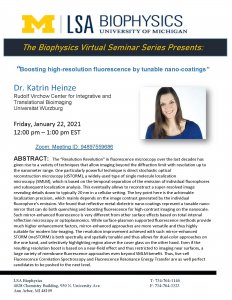
The Biophysics Virtual Seminar Series presents:
Dr. Katrin Heinze - Rudolf Virchow Center for Integrative and
Translational Bioimaging, Universität Würzburg
“Boosting high-resolution fluorescence by tunable nano-coatings"
ABSTRACT: The “Resolution Revolution" in fluorescence microscopy over the last decades has given rise to a variety of techniques that allow imaging beyond the diffraction limit with resolution up to the nanometer range. One particularly powerful technique is direct stochastic optical
reconstruction microscopy (dSTORM), a widely-used type of single molecule localization microscopy (SMLM), which is based on the temporal separation of the emission of individual fluorophores
and subsequent localization analysis. This eventually allows to reconstruct a super-resolved image revealing details down to typically 20 nm in a cellular setting. The key point here is the achievable localization precision, which mainly depends on the image contrast generated by the individual fluorophore’s emission. We found that reflective metal-dielectric nano-coatings represent a tunable nanomirror that can do both quenching and boosting fluorescence for high-contrast imaging on the nanoscale. Such mirror-enhanced fluorescence is very different from other surface effects based on total internal reflection microscopy or optoplasmonics. While surface-plasmon supported fluorescence methods provide much higher enhancement factors, mirror-enhanced approaches are more versatile and thus highly suitable for modern bio-imaging. The resolution improvement achieved with such mirror-enhanced STORM (meSTORM) is both spectrally and spatially tunable and thus allows for dual-color approaches on the one hand, and selectively highlighting region above the cover glass on the other hand. Even if the resulting resolution boost is based on a near-field effect and thus restricted to imaging near surfaces, a large variety of membrane fluorescence approaches even beyond SMLM benefit. Thus, live-cell
Fluorescence Correlation Spectroscopy and Fluorescence Resonance Energy Transfer are as well perfect candidates to be pushed to the next level.
Dr. Katrin Heinze - Rudolf Virchow Center for Integrative and
Translational Bioimaging, Universität Würzburg
“Boosting high-resolution fluorescence by tunable nano-coatings"
ABSTRACT: The “Resolution Revolution" in fluorescence microscopy over the last decades has given rise to a variety of techniques that allow imaging beyond the diffraction limit with resolution up to the nanometer range. One particularly powerful technique is direct stochastic optical
reconstruction microscopy (dSTORM), a widely-used type of single molecule localization microscopy (SMLM), which is based on the temporal separation of the emission of individual fluorophores
and subsequent localization analysis. This eventually allows to reconstruct a super-resolved image revealing details down to typically 20 nm in a cellular setting. The key point here is the achievable localization precision, which mainly depends on the image contrast generated by the individual fluorophore’s emission. We found that reflective metal-dielectric nano-coatings represent a tunable nanomirror that can do both quenching and boosting fluorescence for high-contrast imaging on the nanoscale. Such mirror-enhanced fluorescence is very different from other surface effects based on total internal reflection microscopy or optoplasmonics. While surface-plasmon supported fluorescence methods provide much higher enhancement factors, mirror-enhanced approaches are more versatile and thus highly suitable for modern bio-imaging. The resolution improvement achieved with such mirror-enhanced STORM (meSTORM) is both spectrally and spatially tunable and thus allows for dual-color approaches on the one hand, and selectively highlighting region above the cover glass on the other hand. Even if the resulting resolution boost is based on a near-field effect and thus restricted to imaging near surfaces, a large variety of membrane fluorescence approaches even beyond SMLM benefit. Thus, live-cell
Fluorescence Correlation Spectroscopy and Fluorescence Resonance Energy Transfer are as well perfect candidates to be pushed to the next level.